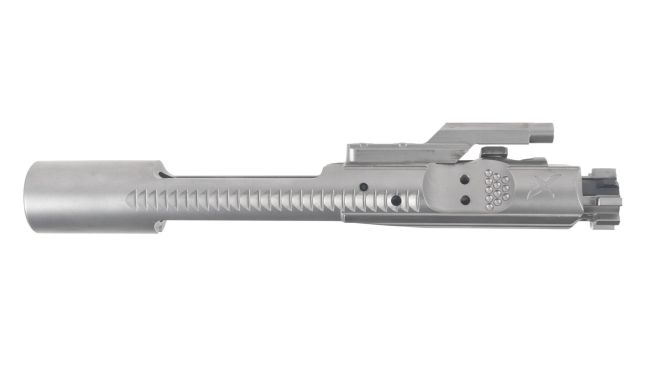Forward Controls Design AR-15 SBCG NP3 (Bolt Carrier Group) - Dimpled
Bolt Carrier Group
In stock
Forward Controls Design AR-15 SBCG NP3 (Bolt Carrier Group) - Dimpled
$261.25
It is Forward Controls view that the factory M16 carriers are very good, and improvements over them would be hard to come by. Modern coatings have made them easy to clean and quite slick, which they can appreciate.
They're not into sacrificing reliability for the sake of light weight, and they view cosmetic changes as anything but fashion that have no place on a combat/duty/defense rifle. They experimented with a slight modification to an existing bolt carrier with regards to ergonomics for slick side uppers, the project had turned into a fun project with practical and reliability improvements.
The S in SBCG stands for Secure Staking, Slick Side. SBCG carrier has a series of serrations or dimples to aid in closing an out of battery bolt on upper receivers without a forward assist. The carrier still has forward assist pawl notches, and so is compatible with forward assist equipped uppers.
The Secure Staking aspect involves SBCG's use of Ned Christiansen's OCKS (Optimized Carrier Key Screws), which when staked properly, offer significant improvement over conventional screws. OCKS have sharp, deep and effective knurling that extends to the top of the screw head. These splines form pockets for carrier key metal to flow into when the key is staked, resulting in gear tooth like engagement.
Some argue that as long as the gas key screws are torqued to spec and staked properly, OCKS aren't necessary. While that's true, for them, it is a matter of over building in areas where providing another layer of fail safe and redundancy is worth the negligible cost. Given the numbers below, the choice of OCKS is an easy one to make.
Since they're so keen on the gas key's staking to ensure its immobility, the question of one piece carrier had come up. It is their opinion that something different isn't always something better. Gas keys can crack, and be dropped and damaged, debris or primer can find its way into the gas key. Their view is based on reality, not a theory, as all of these have happened. A conventional carrier with a separate gas key can simply have its gas key replaced, which is impossible for any one piece carrier.
Each SBCG has its firing pin protrusion checked, gas key torqued and staked, and is individually test fired. SBCG will ship as is, having been slightly lubed and dirtied by the test firing procedure.
The surface is machined in the concave area (forward of the gas vents of the carrier) to facilitate silent bolt closing on upper receivers without a forward assist.
SBCG carriers have a small Cygnus laser engraved. SBCGs are distinctive looking in their own right (form follows function, they didn't go out of their way to make them look different), the subdued logo fits their narrative and practice of modest to secret logo placement. It's an identifier, not an advertising device.
SBCG bolts are manufactured from properly and correctly heat treated 9310 steel. Each Bolt is MPI tested and inspected. Each bolt is shot peened and comes with a Sprinco heavy extractor spring and black O ring. The bolt and cam pin have been NP3 treated to enhance corrosion resistance and carbon build up.
Features:
- Bolt is stress relieved.
- Sprinco 5-Coil Heavy Duty Extractor Spring
- Black Insert
- MPI tested
- SBCG carriers are 8620 steel and machined to USGI specifications.
- The M16/M4 carrier includes a mil-spec gas key. The gas key is heat treated per TDP specifications and NP3 coated. The gas key is secured to the carrier via OCKS (Optimized Carrier Key Screws), torqued to spec values, and properly staked.
- Each carrier assembly is treated with a durable Nickel/PTFE plating which creates a permanently lubricious surface which reduces the need for lubrication.
Torque Specifications:
- Install torque spec is 50-58 in-lb
- Removal torque spec is 55-100 in-lb
- Testing consistently found removal torque of YFS screws averaging around 76 in-lb, with the OCKS consistently at 132 in-lb.
Please NOTE: NP3 has a coefficient of friction as low as .07-.1 according to test standards LFW-1 and ASTM D-2714. Nickel Boron has a coefficient of friction as low as .08-.2. NP3 has PTFE also known as Teflon® co-deposited in the nickel matrix. As wear occurs, new PTFE particles are exposed and the self lubricating properties continue. Nickel boron has a surface with many high points. Because the high points make all the contact, there is less surface area for friction to occur. The problem with this is once the high points wear down the coefficient of friction increases due to more surface area being contacted. With no self lubricating particles like Teflon® in the Nickel Boron matrix, there is no additional lubrication after the contact points are worn. The bottom line is that if you see wear on Nickel Boron, it has lost its “Self Lubricating” properties at that spot.









